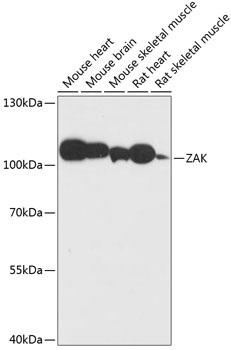Anti-ZAK Antibody (CAB14513)
- SKU:
- CAB14513
- Product type:
- Antibody
- Reactivity:
- Mouse
- Rat
- Host Species:
- Rabbit
- Isotype:
- IgG
- Antibody Type:
- Polyclonal Antibody
Frequently bought together:
Description
| Antibody Name: | Anti-ZAK Antibody |
| Antibody SKU: | CAB14513 |
| Antibody Size: | 20uL, 50uL, 100uL |
| Application: | WB IF |
| Reactivity: | Mouse, Rat |
| Host Species: | Rabbit |
| Immunogen: | Recombinant fusion protein containing a sequence corresponding to amino acids 100-312 of human ZAK (NP_598407.1). |
| Application: | WB IF |
| Recommended Dilution: | WB 1:500 - 1:2000 IF 1:50 - 1:200 |
| Reactivity: | Mouse, Rat |
| Positive Samples: | Mouse heart, Mouse brain, Mouse skeletal muscle, Rat heart, Rat skeletal muscle |
| Immunogen: | Recombinant fusion protein containing a sequence corresponding to amino acids 100-312 of human ZAK (NP_598407.1). |
| Purification Method: | Affinity purification |
| Storage Buffer: | Store at -20°C. Avoid freeze / thaw cycles. Buffer: PBS with 0.02% sodium azide, 50% glycerol, pH7.3. |
| Isotype: | IgG |
| Sequence: | EEMD MDHI MTWA TDVA KGMH YLHM EAPV KVIH RDLK SRNV VIAA DGVL KICD FGAS RFHN HTTH MSLV GTFP WMAP EVIQ SLPV SETC DTYS YGVV LWEM LTRE VPFK GLEG LQVA WLVV EKNE RLTI PSSC PRSF AELL HQCW EADA KKRP SFKQ IISI LESM SNDT SLPD KCNS FLHN KAEW RCEI EATL ERLK KLER DLSF KEQE LKER E |
| Gene ID: | 51776 |
| Uniprot: | |
| Cellular Location: | Cytoplasm, Nucleus |
| Calculated MW: | 35kDa/51kDa/91kDa |
| Observed MW: | 105kDa |
| Synonyms: | MAP3K20, AZK, MLK7, MLT, MLTK, MLTKalpha, MLTKbeta, MRK, SFMMP, ZAK, mlklak, pk |
| Background: | This gene is a member of the MAPKKK family of signal transduction molecules and encodes a protein with an N-terminal kinase catalytic domain, followed by a leucine zipper motif and a sterile-alpha motif (SAM). This magnesium-binding protein forms homodimers and is located in the cytoplasm. The protein mediates gamma radiation signaling leading to cell cycle arrest and activity of this protein plays a role in cell cycle checkpoint regulation in cells. The protein also has pro-apoptotic activity. Alternate transcriptional splice variants, encoding different isoforms, have been characterized. |








